MiGs, Stars & Magic Books: A Brief History of Trespassing in Moscow
An illustrated guide to urban exploration in the Russian capital.

25 November 2020
It doesn’t look like much from the surface: a building the size of a shed, sat in a field on the edge of the Weald in Sussex, where it gazes out across a landscape of low-lying farmland. It is almost a plain brick cube, save for the ventilation grills that line its upper flanks. One might have assumed this structure housed the electrical transformer for a village – had there been any visible power cables, or even a village, nearby.
Ed and Nick are Cold War conservationists. I first found them through their fantastic website, The Time Chamber, and today they’ve taken me on a tour of some of their local sites. Ed unlocks the sturdy door with a key he has on loan from the local farmer, allowing the brothers access to this site which they’ve now spent several years cleaning and conserving. A damp, musty smell greets my nostrils as the door swings open, and inside, this building that looked like little more than an outhouse reveals instead a wide staircase disappearing down into the darkness beneath Sussex: the entrance to the former subterranean radar station called RAF Wartling.
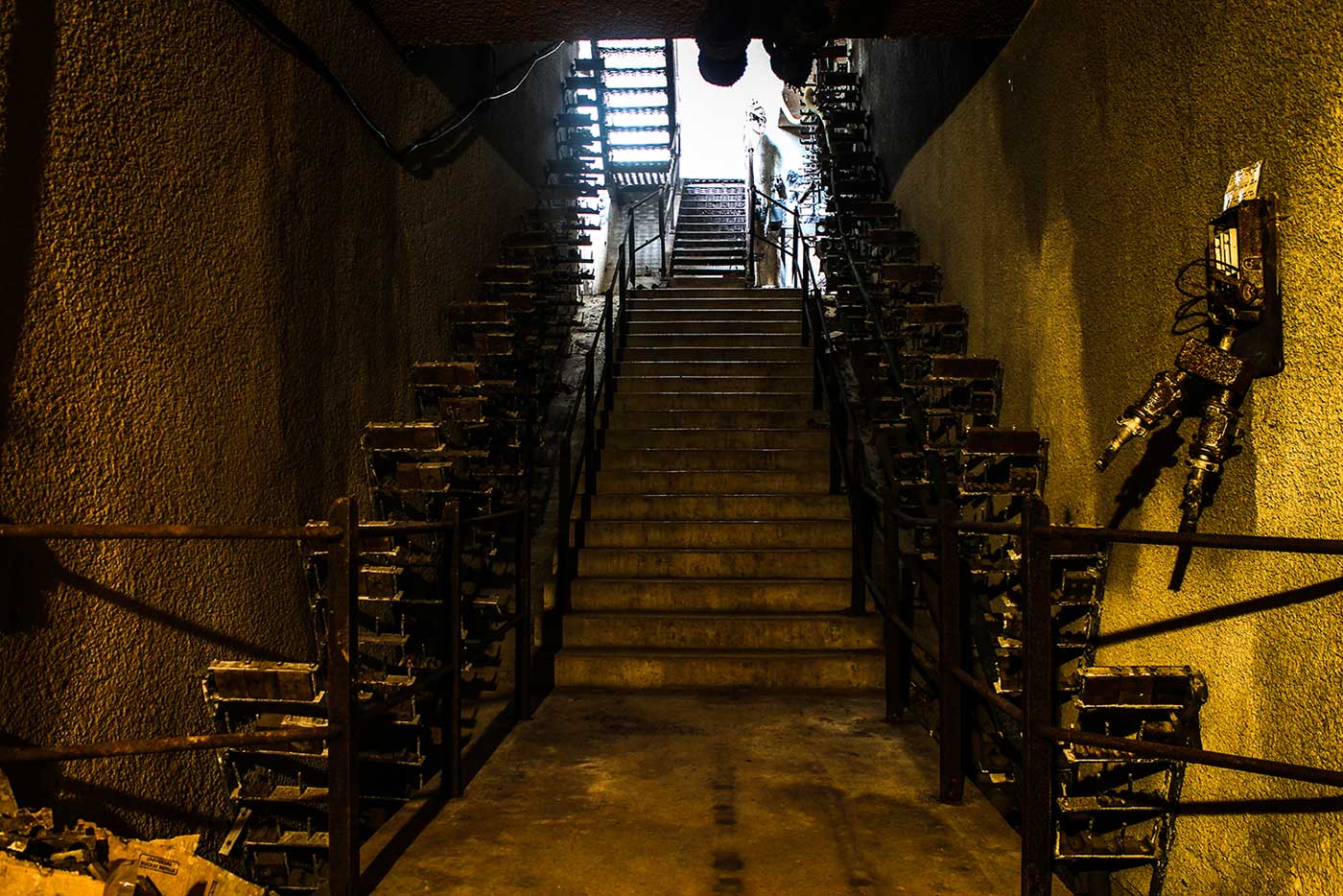
I write a lot about Cold War architecture in the East. I’ve covered underground military bases in Croatia and Ukraine, SAM sites in Bulgaria and Soviet-era satellite bases in Russia. But my own homeland, Britain, is also littered with the physical scars of a generation spent waiting for the worst to happen.
Growing up in the 1980s, I was very much a product of the Cold War era. As a child I remember watching the jets fly over our garden from RAF Brize Norton. While I played with plastic soldiers and WWII Spitfire model kits, just a few dozen miles away an American plane was kept permanently ready in the Quick Reaction Alert area at RAF Upper Heyford; its engine on, pilot alert, a nuclear weapon loaded and just waiting for the order to fly east. A chart on the wall in Upper Heyford’s Mission Control listed the times – in minutes – that various attack craft would take to get a bomb from rural Oxfordshire to Moscow. However, should the Soviets have preempted or retaliated, many believed that the stockpile of WMDs at RAF Upper Heyford might have been one of their first targets.

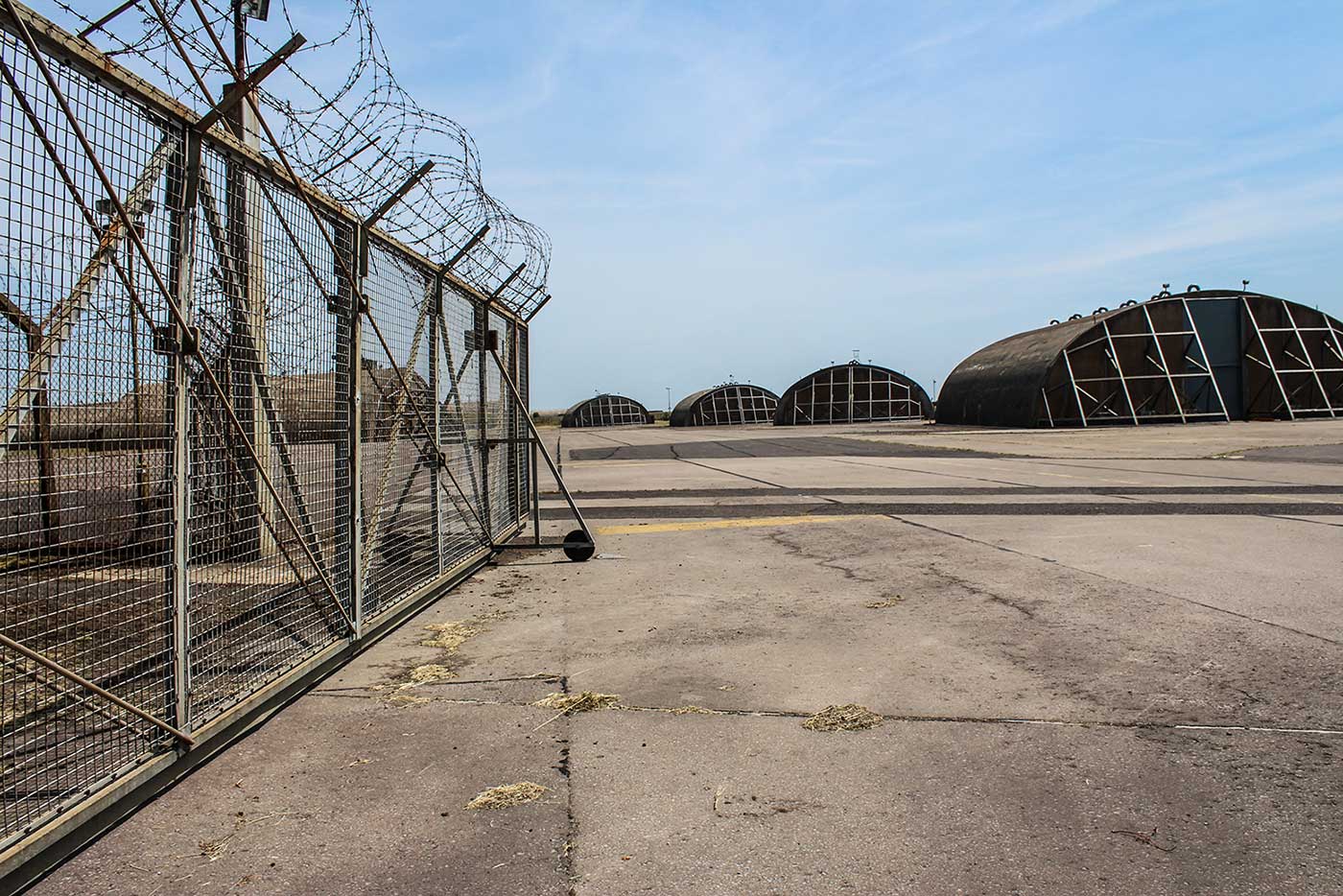
“We were the ground zero target – the American bunkers in England would be the first to be targeted in a nuclear war,” said Annie Tunnicliffe, one of the protestors with Campaign ATOM (‘Against The Oxfordshire Missiles’) <https://www.bbc.com/news/uk-england-oxfordshire-17926177>, who spent much of my childhood picketing the entrance to RAF Upper Heyford. Meanwhile, there I was in my pyjamas, just a few valleys away. If the Cold War ever got hot then I might have been amongst the first to perish.
Should that worst case scenario happen, British citizens had been advised what to do in a series of government pamphlets titled Protect and Survive, and accompanying radio broadcasts that advised: “how to build shelters, avoid fallout, and wrap up your dead loved ones in polythene, bury them, and tag their bodies.” But while we were sheltering from fallout under our kitchen tables, the RAF’s Royal Observer Corps (ROC) would be watching the disaster unfold from a network of 1,563 underground monitoring posts spread throughout the British Isles, from Bodmin to the Isle of Skye.

These ROC nuclear monitoring posts were chiefly constructed between 1957 and 1965, and in the case of a nuclear strike, they would provide the United Kingdom Warning and Monitoring Organisation with detailed reports on surface fallout conditions. The posts – usually built to a standard design featuring a monitoring room, bunks, and a toilet/store room, fourteen feet under the ground – were designed to operate in groups of three. It took three posts working together to accurately triangulate the precise co-ordinates of a nuclear detonation, and to determine whether this was a surface blast, or in the case of a mid-air detonation, its altitude. Three volunteer staff, living inside each subterranean post, would radio regular, detailed reports back to the RAF, like a nuclear-sensitive nervous system relaying sensory information to the brain.
Many of these ROC posts didn’t last past the end of the 1960s. Earlier that decade the Cuban Missile Crisis had put nations on red alert, but after 1964, the premiership of Brezhnev in the USSR saw a thaw in hostilities and when the RAF was downsized and reorganised in 1968, almost half of their nuclear monitoring posts were closed for good. From 1989 until 1991, a chain reaction swept across Europe – beginning with the fall of the Berlin Wall, and ending with the complete dissolution of the Soviet Union. The Cold War ended and the last of Britain’s ROC posts became more or less redundant.
Before we visit the radar base at Wartling, Ed and Nick take me out to Cuckfield – a perfectly pleasant village, 35 miles from London, on the south downs of the Sussex Weald. Past the village, in a farmer’s paddock, the entrance to the Cuckfield ROC Post is a thigh-high concrete stub fitted with air vents and a padlocked hatch. Nick pops the lock open and one-by-one we descend the ladder inside.

The Cuckfield ROC Post has a longer history than most. It first went into service in 1925, when it operated as a Special Constable observer post – serving an interwar, pre-nuclear branch of the Royal Observer Corps, whose volunteers served as ‘spotters’ for the national air defence plan. In June 1962 it was adapted as a nuclear monitoring post. Like many others, the Cuckfield post was initially retired in 1968 due to RAF budget cuts; however flood damage to another nearby post at Ditchling led to that facility’s closure, and Cuckfield was brought back online instead. From 1968 it remained in continuous service as part of a cluster with other posts at Brighton and Lewes, until the entire project was disbanded for good in 1991.
Ed and Nick began restoring the Cuckfield ROC Post in 2009, after successfully persuading the local parish council to allow them access. A survey found the site to be structurally sound, and impressively watertight, though it was largely stripped bare of equipment, while its remaining wooden furniture was speckled with rot. Over the following years the brothers replaced the post’s mouldy contents: painting and repairing its furniture, and replacing Cuckfield’s absent operational equipment with items from their own personal Cold War collection. In some cases they sourced items from other ROC post restorers elsewhere in Britain… of whom there is in fact a sizeable community, they tell me.
The result is a sobering look at the reality of Britain’s post-nuclear defence plan.
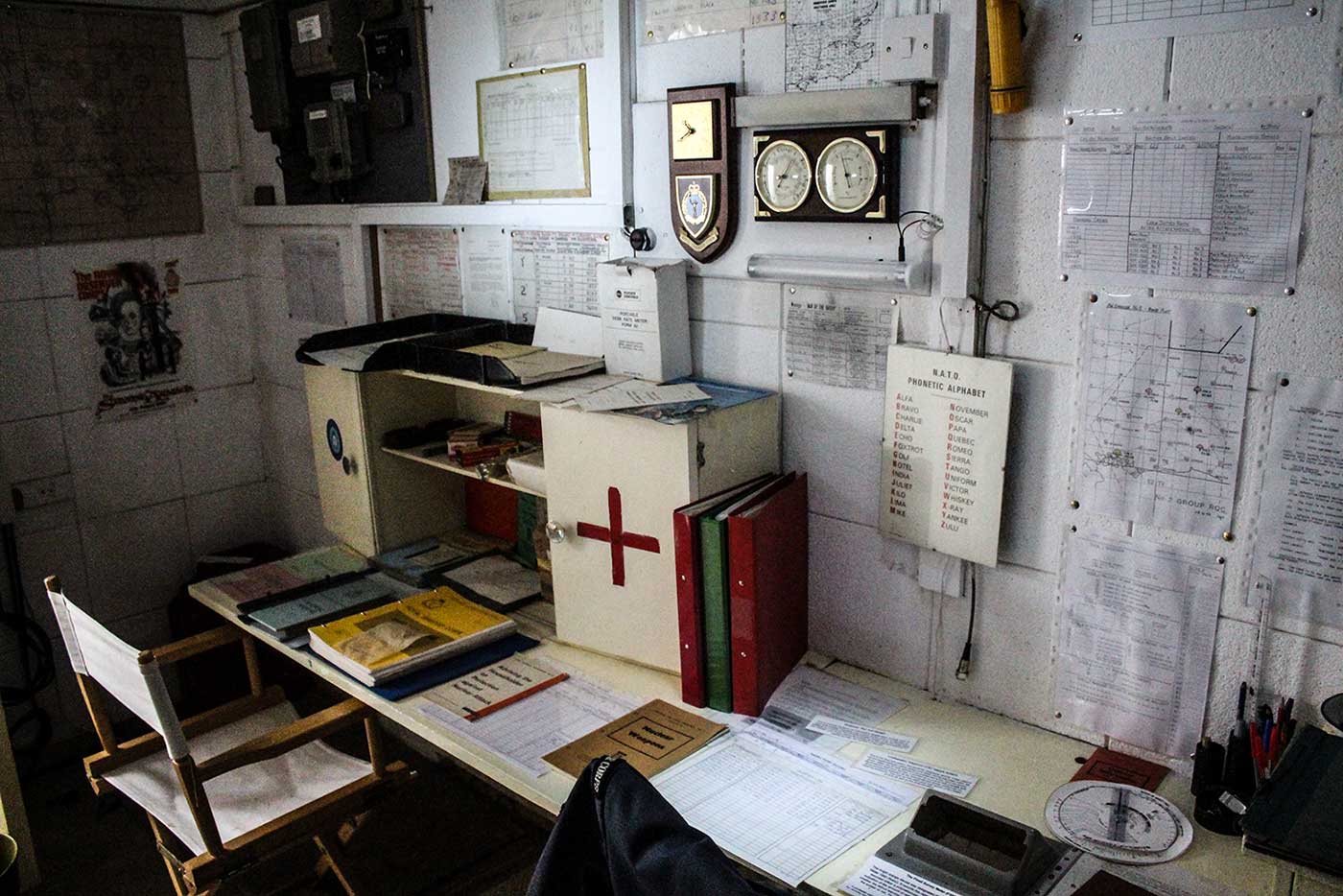

 The cramped space is clean, but overfilled with items and information. The books, stock boxes and desk supplies are too well organised – arranged with military efficiency – to be cluttered exactly, yet still this feels overwhelming. There is not a plain surface in sight, every wall pinned with laminated print-outs, maps, or posters identifying the most common Soviet combat aircraft. Three staff were served with two bunks between them; at all times, at least one volunteer would be awake, and monitoring readings.
The cramped space is clean, but overfilled with items and information. The books, stock boxes and desk supplies are too well organised – arranged with military efficiency – to be cluttered exactly, yet still this feels overwhelming. There is not a plain surface in sight, every wall pinned with laminated print-outs, maps, or posters identifying the most common Soviet combat aircraft. Three staff were served with two bunks between them; at all times, at least one volunteer would be awake, and monitoring readings.
Popular culture of the Cold War period painted a grim picture of the post-apocalyptic landscape. Films like Threads, or When the Wind Blows, showed audiences a future world in ruin, survivors fighting over resources in the bombed-out remnants of cities. But frankly, I don’t know if life would have been so much better for the RAF’s volunteer staff sheltered in 1,563 underground monitoring posts like this.
For me this space starts to feel claustrophobic after the first twenty minutes – I can’t walk from the bunks to the toilet without bumping and squeezing past other bodies. Operators would share a bed and eat food out of tins. Gas masks watched patiently from the shelf, until such a time as the readings decreased sufficiently for these survivors to each strap one over their own face, and brave a visit to the surface. This might have been survival, but it wouldn’t have been much of an existence.
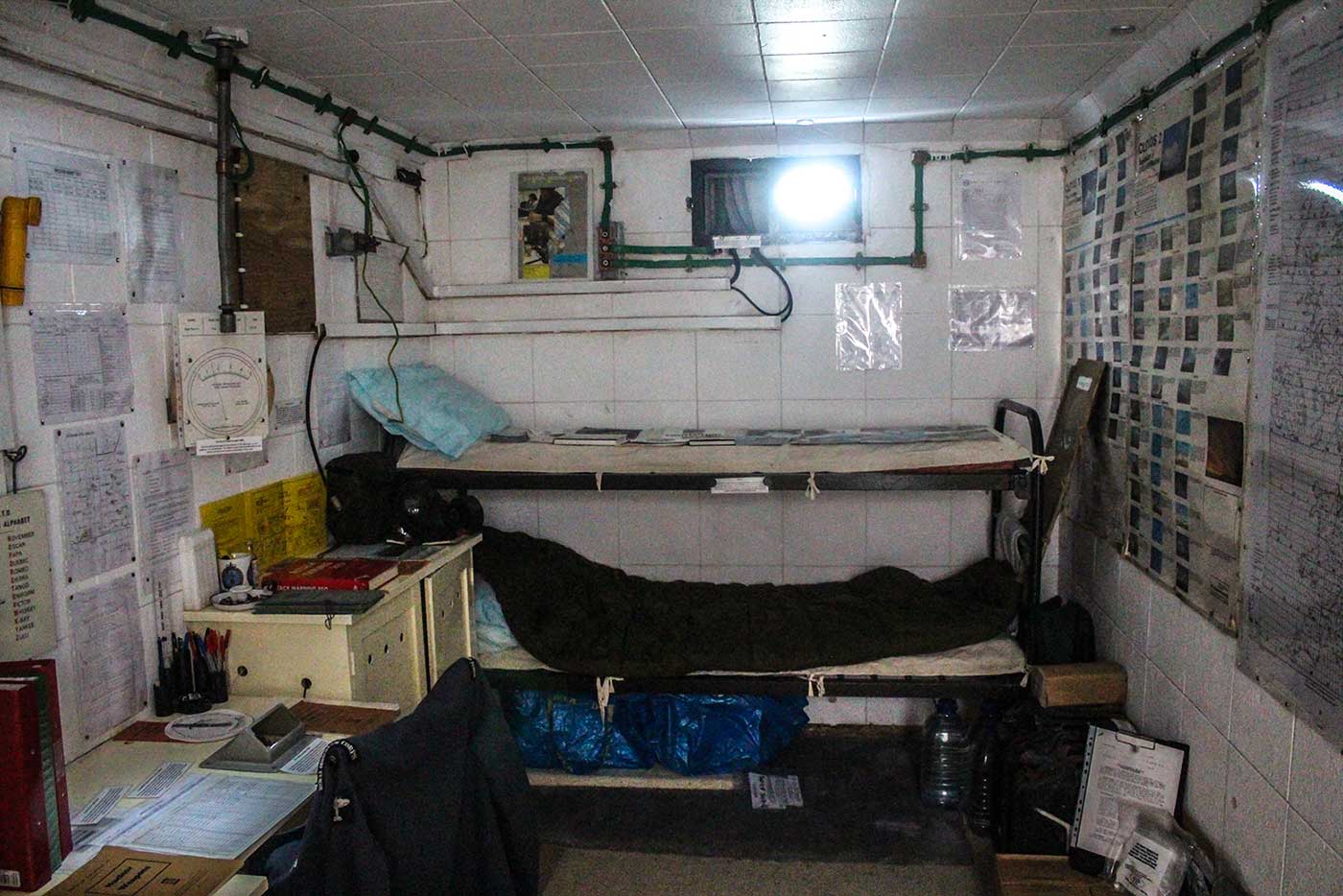


Thirty miles away, and just inland from the stony beaches at Bexhill on England’s southern coast, my guides are involved in another, more ambitious conservation project – at the former RAF Wartling. Whereas the ROC posts represented a worst-case scenario survival system, that plotted the last humans as subterranean cockroaches with clipboards and Geiger counters, the role of the Wartling radar base was to ensure that things never got to that point.


RAF Wartling had radar as early as 1941. Originally it operated as a GCI (Ground-Controlled Interception) radar station, working in tandem with the nearby early-warning system at RAF Pevensey. During WWII, hundreds of German bombs were tracked and intercepted thanks to the crew at RAF Wartling. After the war though, Pevensey closed in 1945. Wartling meanwhile was selected for upgrade to the UK’s newly-launched ‘Rotor’ programme – a Cold War defence initiative – which would grant it a new radar system, as well as a fully defensible operations suite. Constructed between 1951 and 1955, the new complex consisted of a secure two-level bunker, inside walls of 10-inch tungsten-reinforced concrete, capable of withstanding even armour-piercing bombs.
From the small, square entry building on the surface, we descend a wide staircase into semi-darkness; it folds around on itself, winding down beneath the fields. When Nick flicks on a switch, yellowed light spills down mildewed brick walls illuminating a space that looks like the inside of a square tower; only here inverted, a castle ingrown into the earth.


We follow the corridor that forms the backbone of RAF Wartling. Even after years of cleaning and drying the complex, water droplets glisten on the plaster ceiling or gather in shallow puddles across the floor. The location has a propensity for gathering damp, and its years of disuse left it in a sorry state. On the lower floor, we visit technical rooms once fitted with engines, boilers, and air conditioning units – where metal pipes, ladders, and machinery are left furry with red rust from their time spent underwater. The metal frame of a former electrical switchboard illustrates the high-tide mark, its upper portions still finished in grey paint above a clear horizontal line of rust.
In a former operations room, the brothers have found and collected handfuls of map pins and markers – they’re no bigger than the playing pieces from a board game, pink counters and metal pins that would have been pushed around a map to represent the movement of friendly and foreign forces.

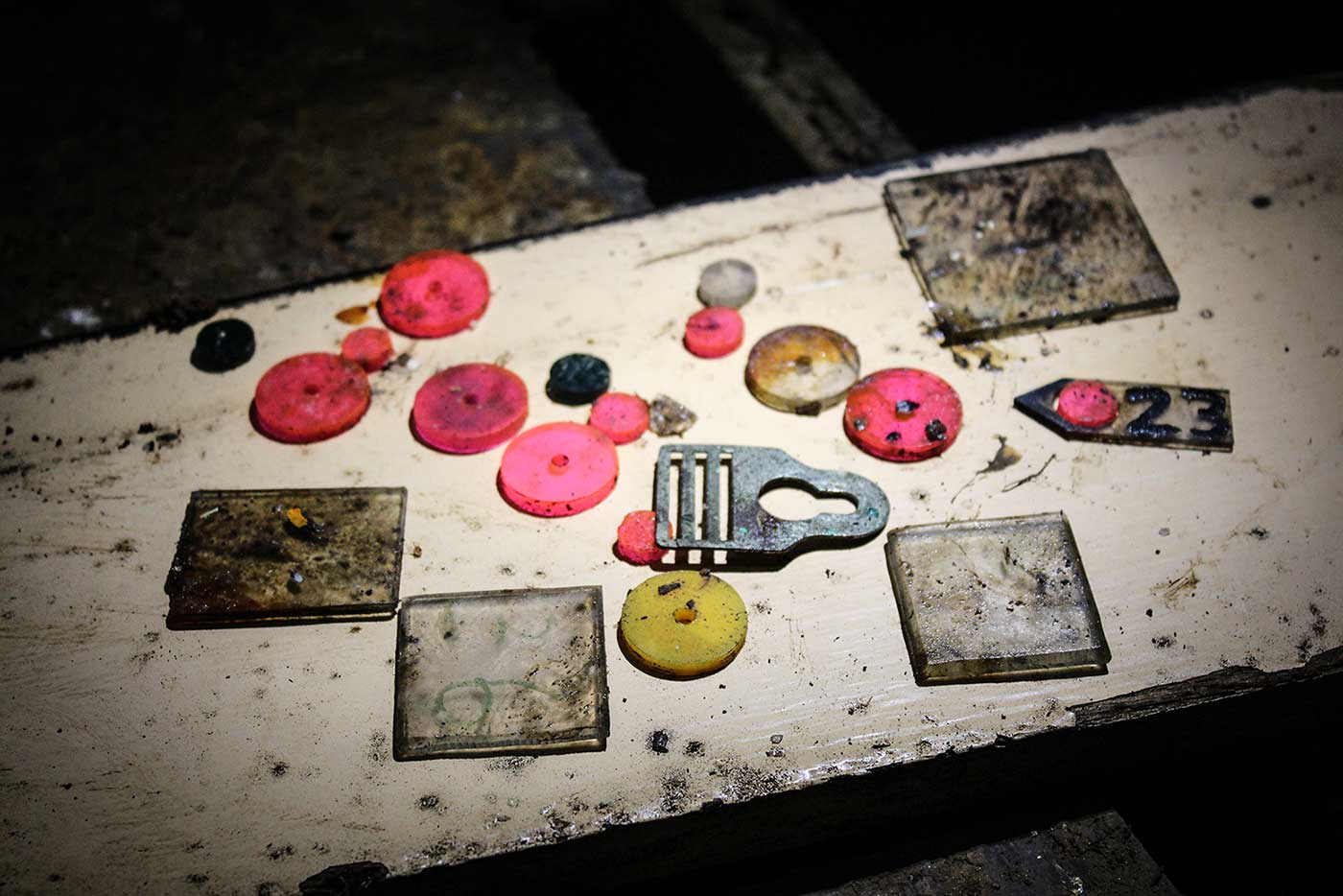
From 1956 onwards, RAF Wartling had featured the new Decca AMES Type 80 search radar. Pointed south, its range allowed it to monitor activity in all British airspace over the Thames. This technology had rendered other nearby radar stations redundant, and after a series of closures, RAF Wartling was made a Master Radar Station in April 1958. Less than a decade later though, Wartling itself began to fall behind. When other Master Radar Stations underwent modernisation with new technology in the 1960s, it was found that fewer stations could be used to cover the same area. The station at Bawdsey was soon able to cover all of Wartling’s duties. (Later, Bawdsey itself would be made obsolete by the further development of the Neatishead radar station.)
RAF Wartling closed in December 1964, and was placed on care and maintenance. It was later sold by the RAF to a private owner – the Marquis of Abergavenny – in 1976. Several of its above-ground buildings were converted into residences, but in the following years the bunker itself fell foul of looting and flooding.

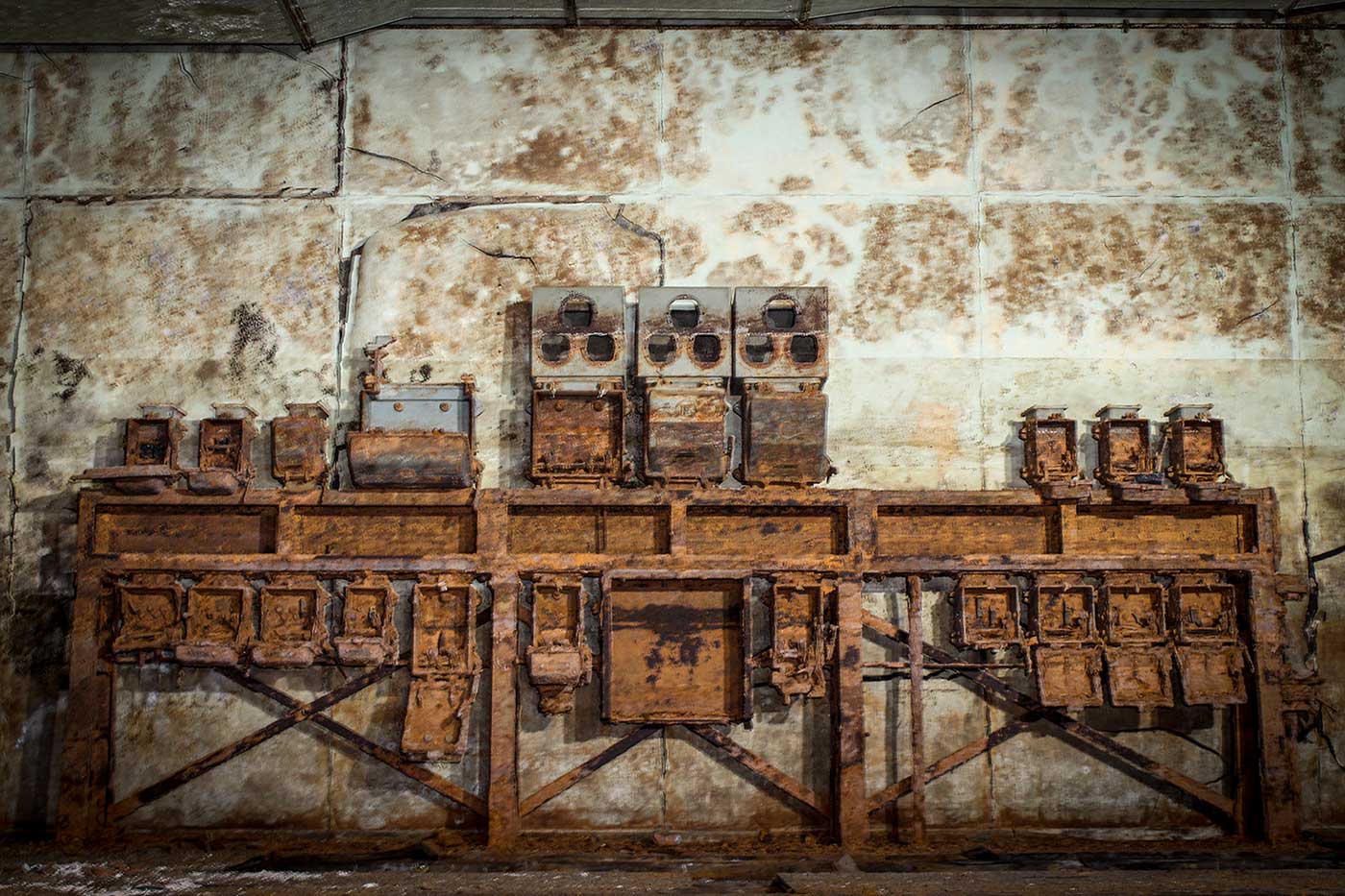
Fortunately, the current landowners have been receptive to the idea of seeing RAF Wartling conserved. Its lowest level remained completely flooded until 2004, but then a project by Subterranea Britannica saw roughly 2.75 million litres of water pumped out of the bunker. Since then Ed and Nick, along with their fellow volunteer conservationists, have completed a number of works on the bunker: sealing water ingress points, fixing the lighting and electrical meters, and restoring walkways and security doors; as well as gathering and cataloguing Wartling’s remaining contents and artefacts. The brothers already host open days at Cuckfield, for visitors to see inside the former ROC post they’ve restored there. While the conservation of the Wartling base is a phenomenally ambitious project, with still much more work to do, the Wartling conservation team ran their first, tentative public tours of the site in 2019, in association with English Heritage.
It is hard to comprehend the wasted potential of a place like RAF Wartling – a state-of-the-art military base constructed at enormous expense beneath the earth, used for nine years, and then abandoned to the worms. It is easy to point to the Soviet Union, and its many visible examples of abandoned Cold War-era megastructures, as illustration of the incredible wastage left behind in the process of preparing for a conflict that never came. But closer to home, even beneath the rolling green fields of the home counties, Britain also hides its own obsolete relics; its elaborate, expensive, and now largely forgotten, Cold War ghosts.
The Time Chamber – Cuckfield ROC Post
The Time Chamber – RAF Wartling ‘ZUN’ R3 GCI/CEW Rotor Radar Station
Sussex Life – How the Cuckfield Royal Observer Corps Post Came to be Restored





Comments are closed.

An illustrated guide to urban exploration in the Russian capital.

Poltergeists, ritual murder & a live-in succubus – the 1000-year-old pub with a ghostly reputation

A month-long monument hunt, and what I learned along the way.
I was a national serviceman and ADO 2 (radar operator) at Wartling between July 1958 and March 1960. I am now 83 years old and cannot recognise much from the photographs of the place where I and my mates “defended” our country “Down the Hole”. However, what is referred to as the entrance was, in fact, the emergency exit. The “dining area” was a canteen and rest room and the walls were covered in painted cartoon murals of WW1 “flying machines”.
Great article. I strongly recommend visiting Kelvedon Hatch to see a large restored bunker. Hopefully this one can be similarly restored and maintained.
Super interesting!
My Dad was at Wartling in the War when in the RAF.
Good times for him in otherwise terrible times and he spoke warmly of his time and colleagues there.
I wonder if records exist of the team there during the war?
He shared a few memories during my early years around 1960/61 while we were still in Eastbourne
Wonderful and yet sad!
It’s beyond my means but hoping one day restoration is feasible.
My Dad was at Wartling in the war – something of which I know very little but he always spoke of his time there warmly.
I wonder if there’s any information about the wartime occupants? I recall mentions of it in my early years up to 1960 m/61 when we moved away from Eastbourne – by that time he was working for the Post Office (telecoms not “sticky stamps and strings” as he called the other side!)
Really interesting article, and some excellent photos. I have visited Hack Green on numerous occasions, and always left with an unsettled feeling (and a curiosity as to what the middle (shut-off) floor is hiding!) Truly sobering places.
Very interested in this item. My Mother served at Wartling
Super interesting!
My Dad was at Wartling in the War when in the RAF.
Good times for him in otherwise terrible times and he spoke warmly of his time and colleagues there.
I wonder if records exist of the team there during the war?
He shared a few memories during my early years around 1960/61 while we were still in Eastbourne
Maybe she knew my Dad! Roy Tanswell
Very cool. Thanks